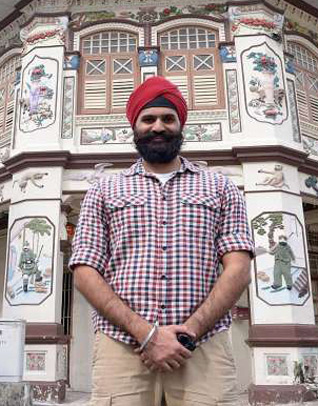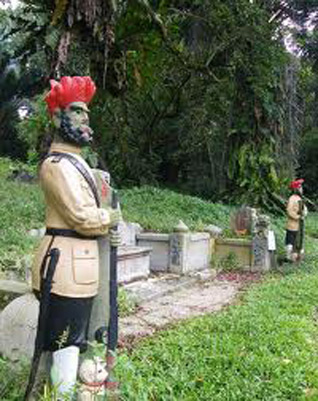Travel
Visual Markers Of Sikh Heritage
YUEN SIN
Standing at the junction of Lorong Bachok and Lorong 19 in Geylang is a striking 1929 shophouse. Its elaborate facade depicts classic Chinese myths and legends.
But a closer look at the pillars at the entrance reveals two carvings of Sikh "jagas" (Malay for guards), designed to "watch over" the building.
Other locations in Singapore that highlight the links between the Sikhs and local history are documented in a new Sikh Heritage Trail mobile application, developed by Sardar Ishvinder Singh, 28, and three others, and launched last month.
He embarked on the project last year almost by accident. Initially nonchalant about the tussle between civil society groups and the Government over the fate of the Bukit Brown Cemetery, his curiosity was piqued when he came across Internet images depicting statues of Sikh guards at Chinese tombs.
The Sikhs came to Singapore in the 19th century as soldiers and policemen in the British colony. After World War II, many sought work in the security industry. Soon, they became so indispensable that their statues were placed before their employers' tombs to continue guarding them symbolically.
The mobile app project, which cost about $10,000, received funding from the National Heritage Board and from Ishvinder’'s contacts within the Sikh community.
He spent every weekend over five months documenting places of interest that had a link to Sikh heritage, with his research partner, Ms Vithya Subramaniam, 26.
The app includes a heritage trail that traces sites linked to the Sikh sepoys working for the British military in the Outram area, and locates nearby gurdwaras, war memorials or gravestones that bear Sikh imagery.
These visual markers of heritage are important not only to provide the "initial draw", but also to reveal the stories beyond the image.
Said Ishvinder: "That's when the concept of a shared heritage comes in. It's about seeing it from the lens of the other community. Why did the Chinese adopt these symbols and take them into the afterlife?"
Ms Subramaniam, a South Asian Studies graduate student at Columbia University, has learnt through her work that the history of the Sikh community's settlement in Singapore is different from that of other Sikh diasporic communities.
She hopes that Sikhs in Singapore will recognise and celebrate their historical role.
Future projects that Ishvinder Singh plans to organise under Sherdil Labs, a firm that he founded last year to promote Sikh heritage, include a heritage centre at the Silat Road Gurdwara and an exhibition on Sikh identity.
It is up to younger Singaporeans to pass on these shared narratives from different cultures, he said.
"If these stories are not covered in our social studies textbooks, then I want to publish them myself. Let us take the lead and search for our own answers, instead of expecting a handout."
* * * * *
FREE APP
The Sikh Heritage Trail app is free to download on all iOS applications. An Android version will be launched in about three months. More information can be found by CLICKING here.
[Courtesy: Straits Times. Edited for sikhchic.com]
December 2, 2015




